CitySpeed: A Crowdsensing-Based Integrated Platform for General-Purpose Monitoring of Vehicular Speeds in Smart Cities
Abstract
:1. Introduction
- Traffic load: The monitoring of traffic conditions in order to verify and to monitor vehicle speeds is an important service in urban centers, but it is also a complex task. This is due, among other factors, to the presence of various traffic elements (pedestrians, motor vehicles, and non-motorized vehicles), often on a large scale. This problem encourages the development of mechanisms to estimate the traffic load and to predict it;
- Traffic planning: Efficient mobility planning is achieved when the traffic load is known, allowing modifications in the traffic flows and also advising the construction of new roads, bridges, and viaducts. For this, historical traffic information is highly required;
- Public data: The CitySpeed platform acquires data about vehicle speeds and stores such data in a public and open database, which can then be easily exploited by any other application. Such data can also be retrieved in a well-formatted standard (JSON);
- Historical data: All acquired data are available to be accessed, allowing historical processing and visualization of vehicle speeds. This may be highly desirable for better planning of traffic and general mobility in modern cities;
- Speed computing confidence: The speeds are sampled and stored based on global positioning service (GPS) reading, which is a cheap and acceptable mechanism for this purpose. Measurements through the OBD-II interface were also performed and the results were compared to the chosen method, validating it (discussed in Section 4);
- Data visualization: Although the platform is mostly aimed at providing public data, some reference visualization methods were also implemented, allowing different forms of graphical presentation of the data.
2. Related Works
3. The CitySpeed Platform
- The source code of all parts of the platform is public and can be freely used and/or altered. The code is available on the Github platform, and can be downloaded from “https://github.com/lablara/cityspeed.git”;
- The CitySpeed platform was developed to be ubiquitous, to consume low amounts of energy, and to require low storage space on smartphones;
- In order to reduce communication costs, all collected data are only transmitted to the proper server when a smartphone is connected to a Wi-Fi network. This standard behavior can be changed by the user, allowing smartphones to transmit data through 3G/4G connections;
- The platform was developed to be smoothly executed on Android and IOS smartphone systems; and
- Web-based graphical tools were developed, allowing different types of visualization of the retrieved data.
3.1. Logical Blocks
- GPS-based speed monitoring: Instantaneous speeds are continuously acquired and stored locally in a smartphone (CitySpeed_App);
- Speed data are transmitted and permanently stored in the system’s database: The designed app transmits the previously stored data to the configured server (CitySpeed_Server);
- Transmission confirmation: This allows a smartphone app to safely remove the temporarily stored data (CitySpeed_App);
- Data are transformed and stored in a second database: Speed data can now be publicly accessed (CitySpeed_Server);
- Data are retrieved to be processed and displayed: Different visualization pages are available, but any extensions can be developed (CitySpeed_Viewer).
3.1.1. CitySpeed_App
- Timestamp: The time in which the speed sample was generated;
- Speed: Directly acquired from the GPS receiver. The API does not compute it, since it is provided by the GPS module on modern smartphones;
- Latitude: The latitude information provided by the GPS receiver and associated to the computed speed; and
- Longitude: The longitude information provided by the GPS receiver and associated to the computed speed.
3.1.2. CitySpeed_Server
3.1.3. CitySpeed_Viewer
- Time queries: A date range, or even a time frequency, may be specified, showing speed information for that time, every day in a period;
- Address queries: A country, city, and street may be used as search parameters, allowing different levels of specifications of the search set;
- Radius queries: A spot is selected on the displayed map and a radius may be defined in meters, retrieving data for the defined area.
3.2. Development Issues
3.3. Privacy and Security Concerns
4. Results and Experiments
4.1. Validation of Speed Computing
4.2. Monitoring in Urban Areas
5. Perspectives of the CitySpeed Platform for Smart Cities
5.1. Crowdsensing and People Engagement
5.2. Potential Applications
6. Conclusions
Author Contributions
Funding
Conflicts of Interest
References
- Egger, S. Determining a sustainable city model. Environ. Model. Softw. 2006, 21, 1235–1246. [Google Scholar] [CrossRef]
- Silva, B.N.; Khan, M.; Han, K. Towards sustainable smart cities: A review of trends, architectures, components, and open challenges in smart cities. Sustain. Cities Soc. 2018, 38, 697–713. [Google Scholar] [CrossRef]
- Talari, S.; Shafie-khah, M.; Siano, P.; Loia, V.; Tommasetti, A.; Catalão, J.P.S. A Review of Smart Cities Based on the Internet of Things Concept. Energies 2017, 10, 421. [Google Scholar] [CrossRef]
- Allam, Z.; Newman, P. Redefining the Smart City: Culture, Metabolism and Governance. Smart Cities 2018, 1, 4–25. [Google Scholar] [CrossRef]
- Alvear, O.; Calafate, C.T.; Cano, J.C.; Manzoni, P. Crowdsensing in Smart Cities: Overview, Platforms, and Environment Sensing Issues. Sensors 2018, 18, 460. [Google Scholar] [CrossRef] [PubMed]
- Zanella, A.; Bui, N.; Castellani, A.; Vangelista, L.; Zorzi, M. Internet of Things for Smart Cities. IEEE Internet Things J. 2014, 1, 22–32. [Google Scholar] [CrossRef]
- Costa, D.G.; Collotta, M.; Pau, G.; Duran-Faundez, C. A Fuzzy-Based Approach for Sensing, Coding and Transmission Configuration of Visual Sensors in Smart City Applications. Sensors 2017, 17, 93. [Google Scholar] [CrossRef] [PubMed]
- Lin, J.; Yu, W.; Zhang, N.; Yang, X.; Zhang, H.; Zhao, W. A Survey on Internet of Things: Architecture, Enabling Technologies, Security and Privacy, and Applications. IEEE Internet Things J. 2017, 4, 1125–1142. [Google Scholar] [CrossRef]
- Costa, D.G.; Duran-Faundez, C.; Andrade, D.C.; Rocha-Junior, J.B.; Just Peixoto, J.P. TwitterSensing: An Event-Based Approach for Wireless Sensor Networks Optimization Exploiting Social Media in Smart City Applications. Sensors 2018, 18, 1080. [Google Scholar] [CrossRef] [PubMed]
- Mota, V.F.; Silva, T.H.; Macedo, D.F.; Ghamri-Doudane, Y.; Nogueira, J.M. Towards scalable mobile crowdsensing through device-to-device communication. J. Netw. Comput. Appl. 2018, 122, 99–106. [Google Scholar] [CrossRef]
- Liu, J.; Shen, H.; Narman, H.S.; Chung, W.; Lin, Z. A Survey of Mobile Crowdsensing Techniques: A Critical Component for The Internet of Things. ACM Trans. Cyber-Phys. Syst. 2018, 2, 18:1–18:26. [Google Scholar] [CrossRef]
- Johansson, C.; Lövenheim, B.; Schantz, P.; Wahlgren, L.; Almström, P.; Markstedt, A.; Strömgren, M.; Forsberg, B.; Sommar, J.N. Impacts on air pollution and health by changing commuting from car to bicycle. Sci. Total Environ. 2017, 584–585, 55–63. [Google Scholar] [CrossRef] [PubMed]
- Silva, M.; Signoretti, G.; Oliveira, J.; Silva, I.; Costa, D.G. A Crowdsensing Platform for Monitoring of Vehicular Emissions: A Smart City Perspective. Future Internet 2019, 11, 13. [Google Scholar] [CrossRef]
- Wu, X.; Wu, Y.; Zhang, S.; Liu, H.; Fu, L.; Hao, J. Assessment of vehicle emission programs in China during 1998–2013: Achievement, challenges and implications. Environ. Pollut. 2016, 214, 556–567. [Google Scholar] [CrossRef] [PubMed]
- Google. Google Maps. Available online: https://maps.google.com/ (accessed on 2 January 2019).
- Mobile, G. Waze. Available online: https://www.waze.com (accessed on 2 January 2019).
- Costa, D.G.; Duran-Faundez, C. Open-Source Electronics Platforms as Enabling Technologies for Smart Cities: Recent Developments and Perspectives. Electronics 2018, 7, 404. [Google Scholar] [CrossRef]
- Habibzadeh, H.; Soyata, T.; Kantarci, B.; Boukerche, A.; Kaptan, C. Sensing, communication and security planes: A new challenge for a smart city system design. Comput. Netw. 2018, 144, 163–200. [Google Scholar] [CrossRef]
- Anand, P.; NavÃ-o-Marco, J. Governance and economics of smart cities: opportunities and challenges. Telecommun. Policy 2018, 42, 795–799. [Google Scholar] [CrossRef]
- Alavi, A.H.; Jiao, P.; Buttlar, W.G.; Lajnef, N. Internet of Things-enabled smart cities: State-of-the-art and future trends. Measurement 2018, 129, 589–606. [Google Scholar] [CrossRef]
- Nagy, A.M.; Simon, V. Survey on traffic prediction in smart cities. Pervasive Mob. Comput. 2018, 50, 148–163. [Google Scholar] [CrossRef]
- Braun, T.; Fung, B.C.; Iqbal, F.; Shah, B. Security and privacy challenges in smart cities. Sustain. Cities Soc. 2018, 39, 499–507. [Google Scholar] [CrossRef]
- Pramanik, M.I.; Lau, R.Y.; Demirkan, H.; Azad, M.A.K. Smart health: Big data enabled health paradigm within smart cities. Expert Syst. Appl. 2017, 87, 370–383. [Google Scholar] [CrossRef]
- Lyons, G. Getting smart about urban mobility—Aligning the paradigms of smart and sustainable. Transp. Res. Part A Policy Pract. 2018, 115, 4–14. [Google Scholar] [CrossRef]
- Petkovics, A.; Simon, V.; Gódor, I.; Böröcz, B. Crowdsensing Solutions in Smart Cities: Introducing a Horizontal Architecture. In Proceedings of the 13th International Conference on Advances in Mobile Computing and Multimedia, MoMM, Brussels, Belgium, 11–13 December 2015; pp. 33–37. [Google Scholar]
- Li, X.; Goldberg, D.W. Toward a mobile crowdsensing system for road surface assessment. Comput. Environ. Urban Syst. 2018, 69, 51–62. [Google Scholar] [CrossRef]
- Singh, G.; Bansal, D.; Sofat, S. A smartphone based technique to monitor driving behavior using DTW and crowdsensing. Pervasive Mob. Comput. 2017, 40, 56–70. [Google Scholar] [CrossRef]
- Villanueva, F.J.; Villa, D.; Santofimia, M.J.; Barba, J.; López, J.C. Crowdsensing smart city parking monitoring. In Proceedings of the 2015 IEEE 2nd World Forum on Internet of Things (WF-IoT), Milan, Italy, 14–16 December 2015; pp. 751–756. [Google Scholar]
- Rahman, S.A.; Mourad, A.; Barachi, M.E.; Orabi, W.A. A novel on-demand vehicular sensing framework for traffic condition monitoring. Veh. Commun. 2018, 12, 165–178. [Google Scholar]
- Bajaj, G.; Bouloukakis, G.; Pathak, A.; Singh, P.; Georgantas, N.; Issarny, V. Toward Enabling Convenient Urban Transit through Mobile Crowdsensing. In Proceedings of the 2015 IEEE 18th International Conference on Intelligent Transportation Systems, Las Palmas, Spain, 15–18 September 2015; pp. 290–295. [Google Scholar]
- Liu, Z.; Jiang, S.; Zhou, P.; Li, M. A Participatory Urban Traffic Monitoring System: The Power of Bus Riders. IEEE Trans. Intell. Transp. Syst. 2017, 18, 2851–2864. [Google Scholar] [CrossRef]
- Cardone, G.; Corradi, A.; Foschini, L.; Ianniello, R. ParticipAct: A Large-Scale Crowdsensing Platform. IEEE Trans. Emerg. Top. Comput. 2016, 4, 21–32. [Google Scholar] [CrossRef]
- Hu, X.; Chu, T.H.S.; Chan, H.C.B.; Leung, V.C.M. Vita: A Crowdsensing-Oriented Mobile Cyber-Physical System. IEEE Trans. Emerg. Top. Comput. 2013, 1, 148–165. [Google Scholar] [CrossRef]
- Messaoud, R.B.; Rejiba, Z.; Ghamri-Doudane, Y. An energy-aware end-to-end Crowdsensing platform: Sensarena. In Proceedings of the 2016 13th IEEE Annual Consumer Communications Networking Conference (CCNC), Las Vegas, NV, USA, 9–12 January 2016; pp. 284–285. [Google Scholar]
- Dutta, J.; Gazi, F.; Roy, S.; Chowdhury, C. AirSense: Opportunistic crowd-sensing based air quality monitoring system for smart city. In Proceedings of the 2016 IEEE SENSORS, Orlando, FL, USA, 30 October–3 November 2016; pp. 1–3. [Google Scholar]
- Zappatore, M.; Longo, A.; Bochicchio, M.A. Using mobile crowd sensing for noise monitoring in smart cities. In Proceedings of the 2016 International Multidisciplinary Conference on Computer and Energy Science (SpliTech), Split, Croatia, 13–15 July 2016; pp. 1–6. [Google Scholar]
- Wang, C.; Zhang, Z.; Shao, L.; Zhou, M. Estimating travel speed via sparse vehicular crowdsensing data. In Proceedings of the 2016 IEEE 3rd World Forum on Internet of Things (WF-IoT), Reston, VA, USA, 12–14 December 2016; pp. 643–648. [Google Scholar]
- TransistorSoftware. Cordova Background Geolocation API. Available online: https://www.transistorsoft.com/shop/products/cordova-background-geolocation (accessed on 2 January 2019).
- SQLite. SQLite Database System. Available online: https://www.sqlite.org (accessed on 2 January 2019).
- Firebase. Google Firebase Database System. Available online: https://firebase.google.com (accessed on 2 January 2019).
- PostgreSQL. PostgreSQL Database System. Available online: https://www.postgresql.org (accessed on 2 January 2019).
- PostGIS. PostGIS Database System. Available online: https://postgis.net/= (accessed on 2 January 2019).
- Framework, I. Ionic. Available online: https://ionicframework.com (accessed on 2 January 2019).
- Kaplan, E.; Hegarty, C. Understanding GPS: Principles and Applications; Artech House: Norwood, MA, USA, 2005. [Google Scholar]
- Ferris, D.H. Global OBD Legislation Update (Worldwide Requirements). Available online: http://www.sae.org/events/training/symposia/obd/presentations/2009/d1daveferris.pdf (accessed on 4 August 2017).
- WGSoft. ScanMaster-ELM. Available online: https://www.wgsoft.de/shop/obd-software/4/scanmaster-elm-f.-elm327 (accessed on 2 January 2019).
- Zhang, X.; Yang, Z.; Sun, W.; Liu, Y.; Tang, S.; Xing, K.; Mao, X. Incentives for Mobile Crowd Sensing: A Survey. IEEE Commun. Surv. Tutor. 2016, 18, 54–67. [Google Scholar] [CrossRef]
- Firmanuddin, G.; Supangkat, S.H. City analytic development for modeling population using data analysis prediction. In Proceedings of the 2016 International Conference on ICT For Smart Society (ICISS), Surabaya, Indonesia, 20–21 July 2016; pp. 12–15. [Google Scholar]
- Jin, J.; Gubbi, J.; Marusic, S.; Palaniswami, M. An Information Framework for Creating a Smart City through Internet of Things. IEEE Internet Things J. 2014, 1, 112–121. [Google Scholar] [CrossRef]
- Ishida, T. Digital City, Smart City and Beyond. In Proceedings of the 26th International Conference on World Wide Web Companion, Perth, Australia, 3–7 April 2017; International World Wide Web Conferences Steering Committee: Geneva, Switzerland, 2017; pp. 1151–1152. [Google Scholar]
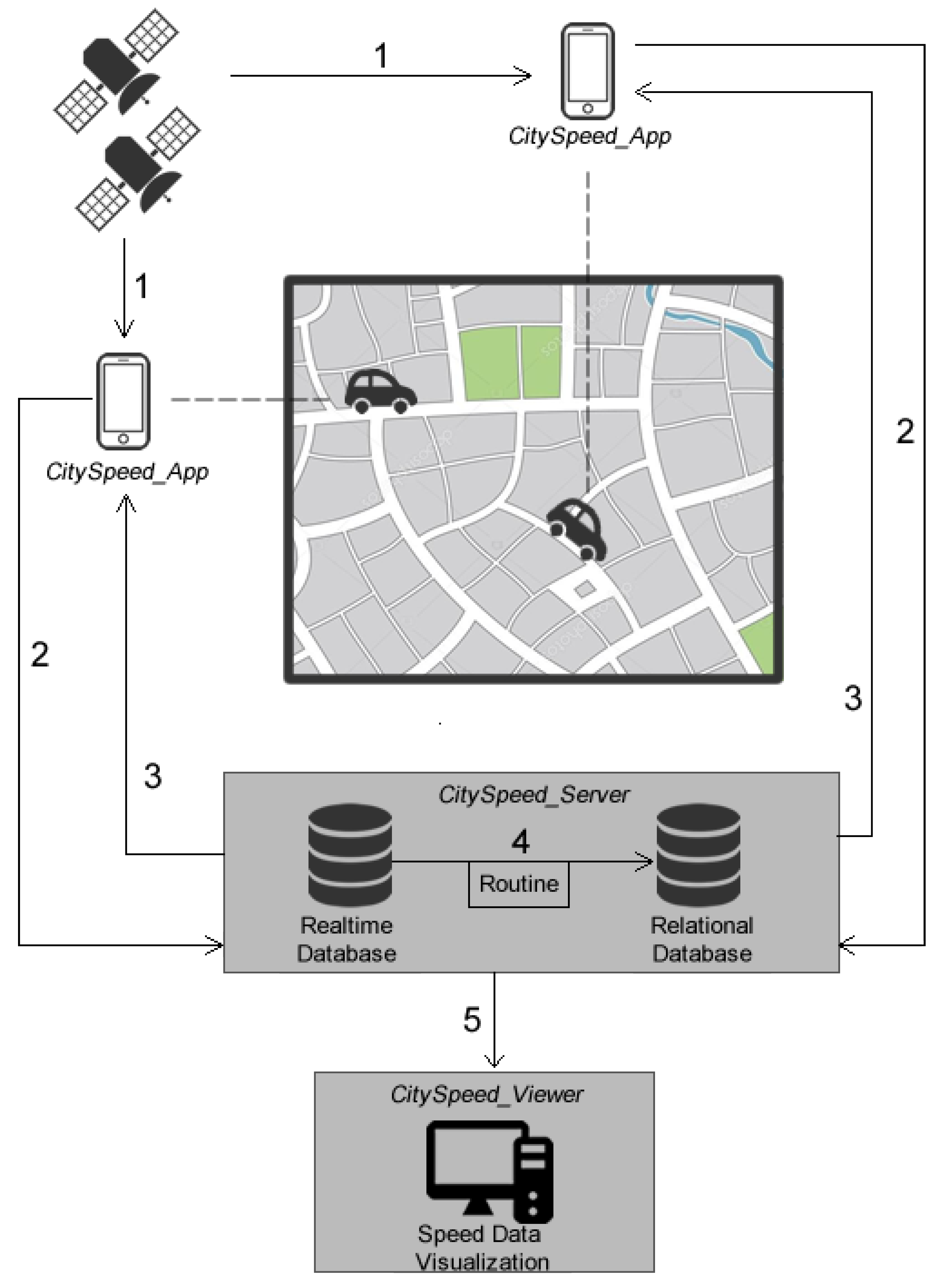
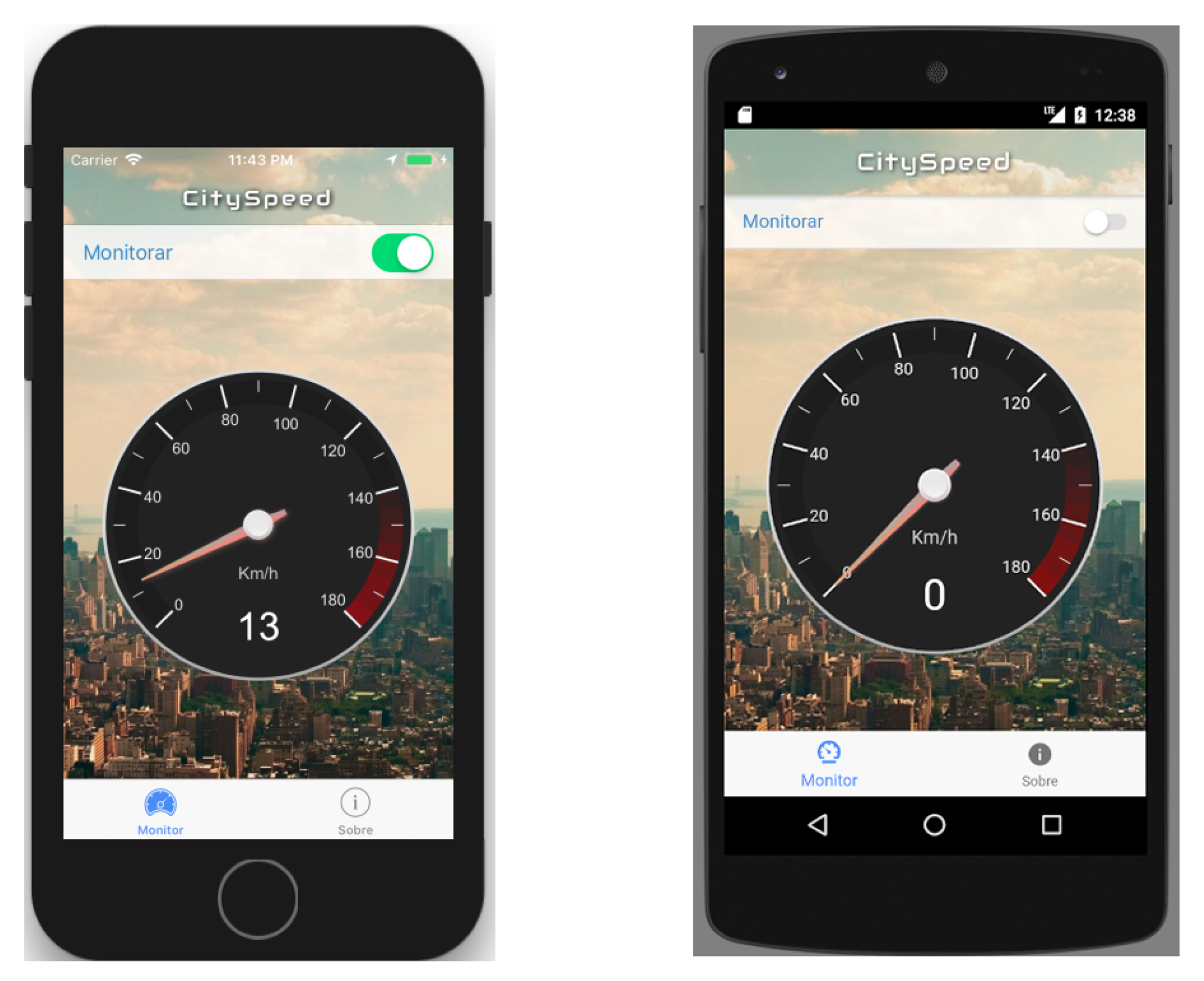
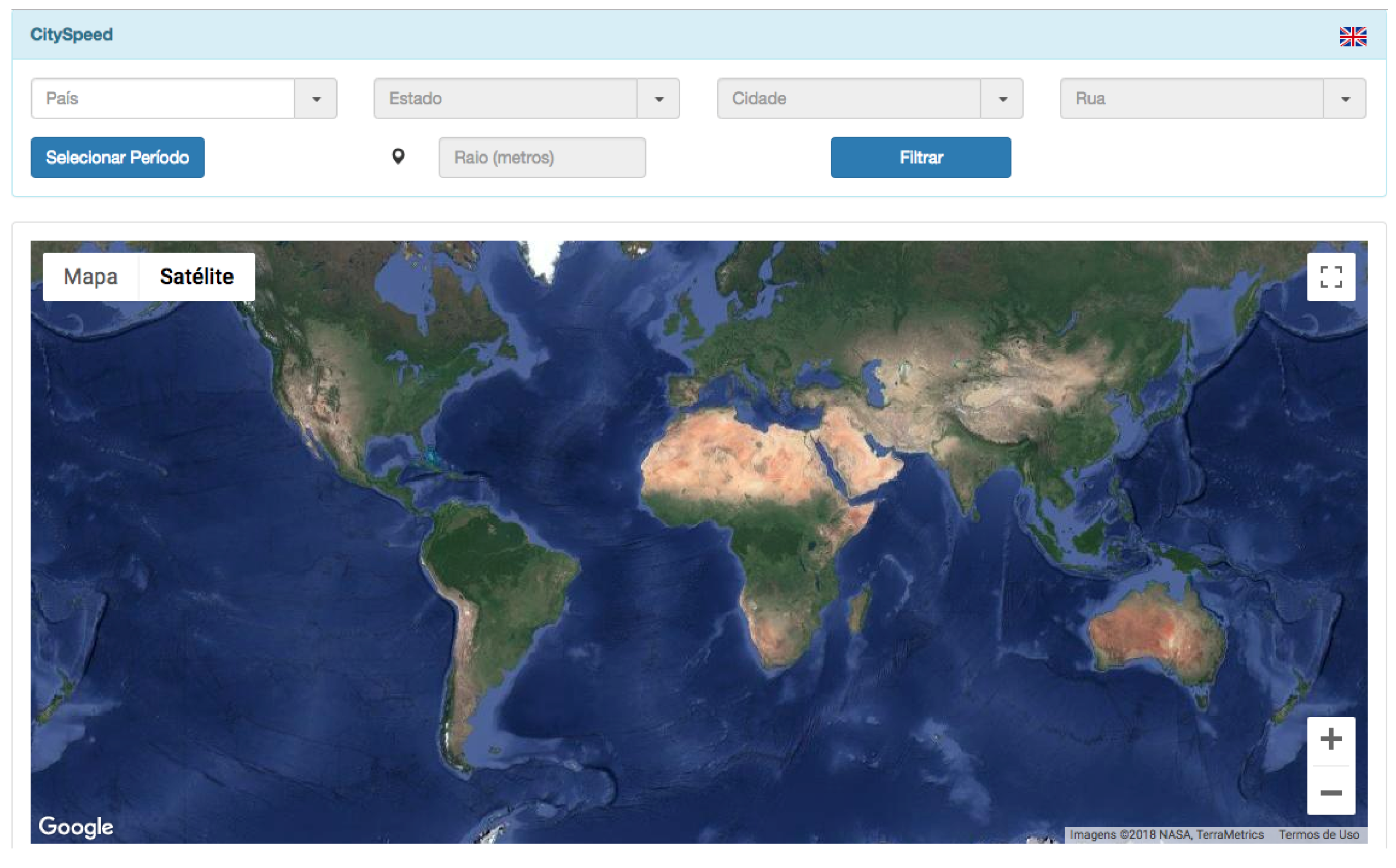
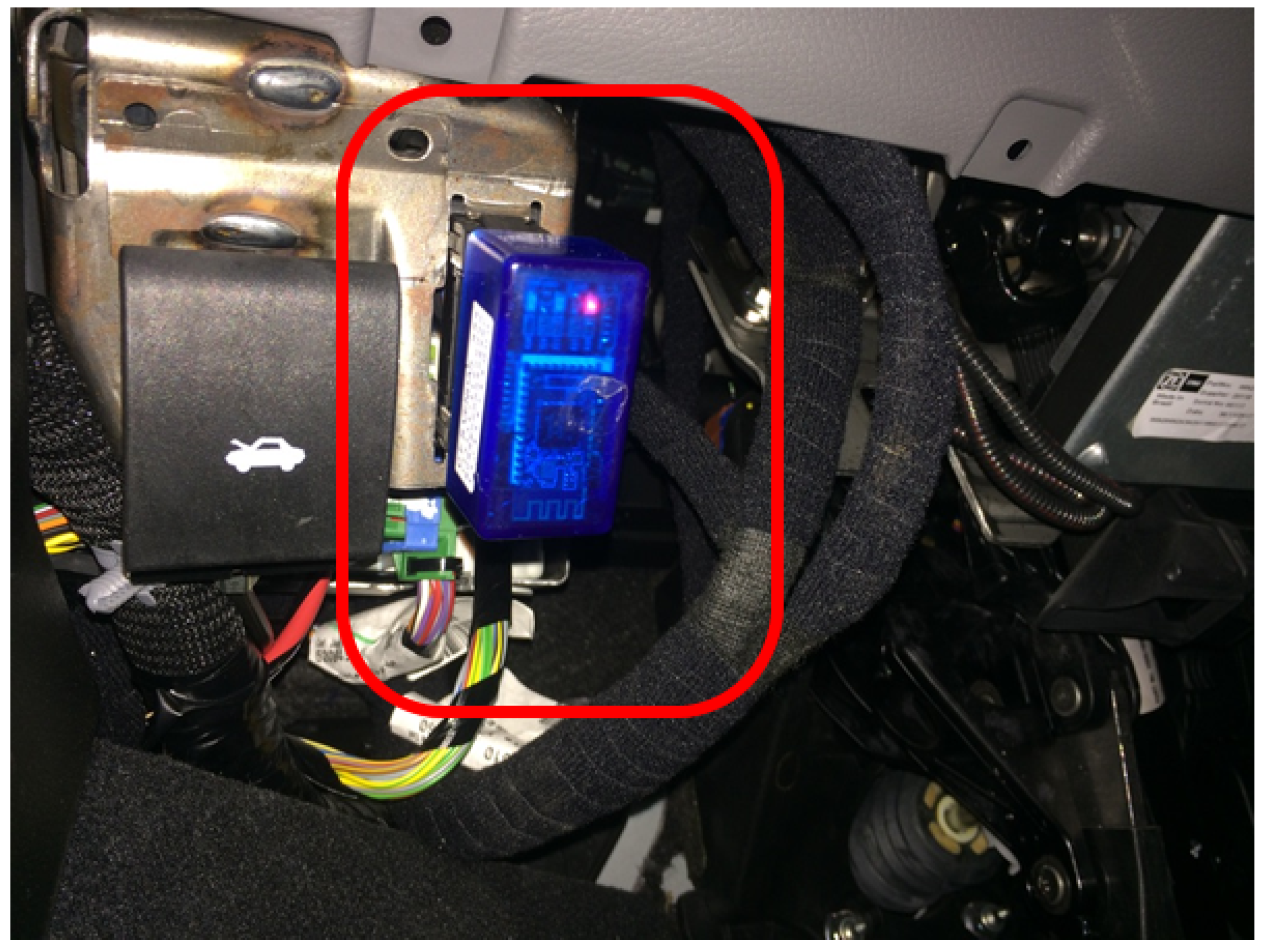
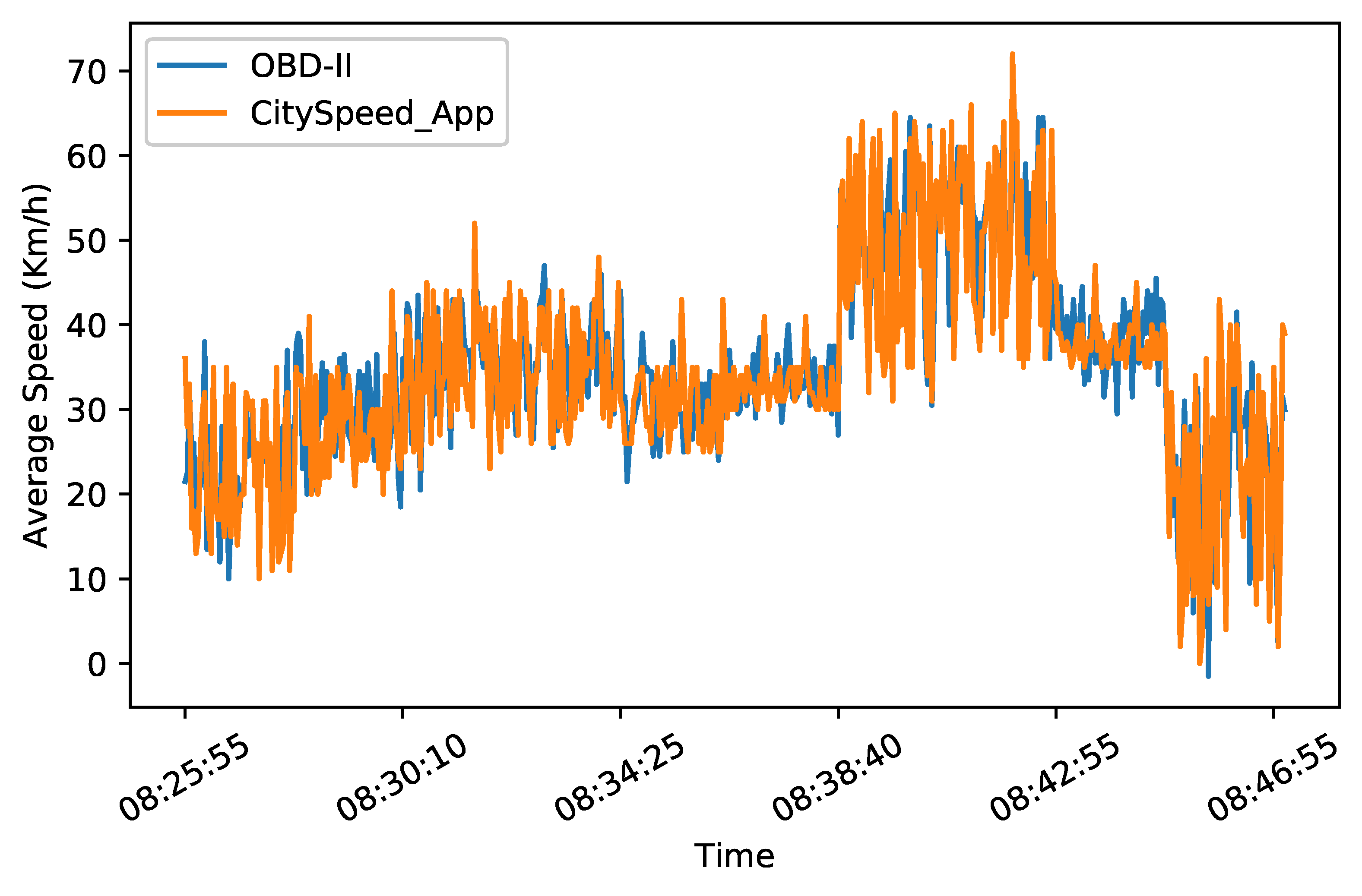
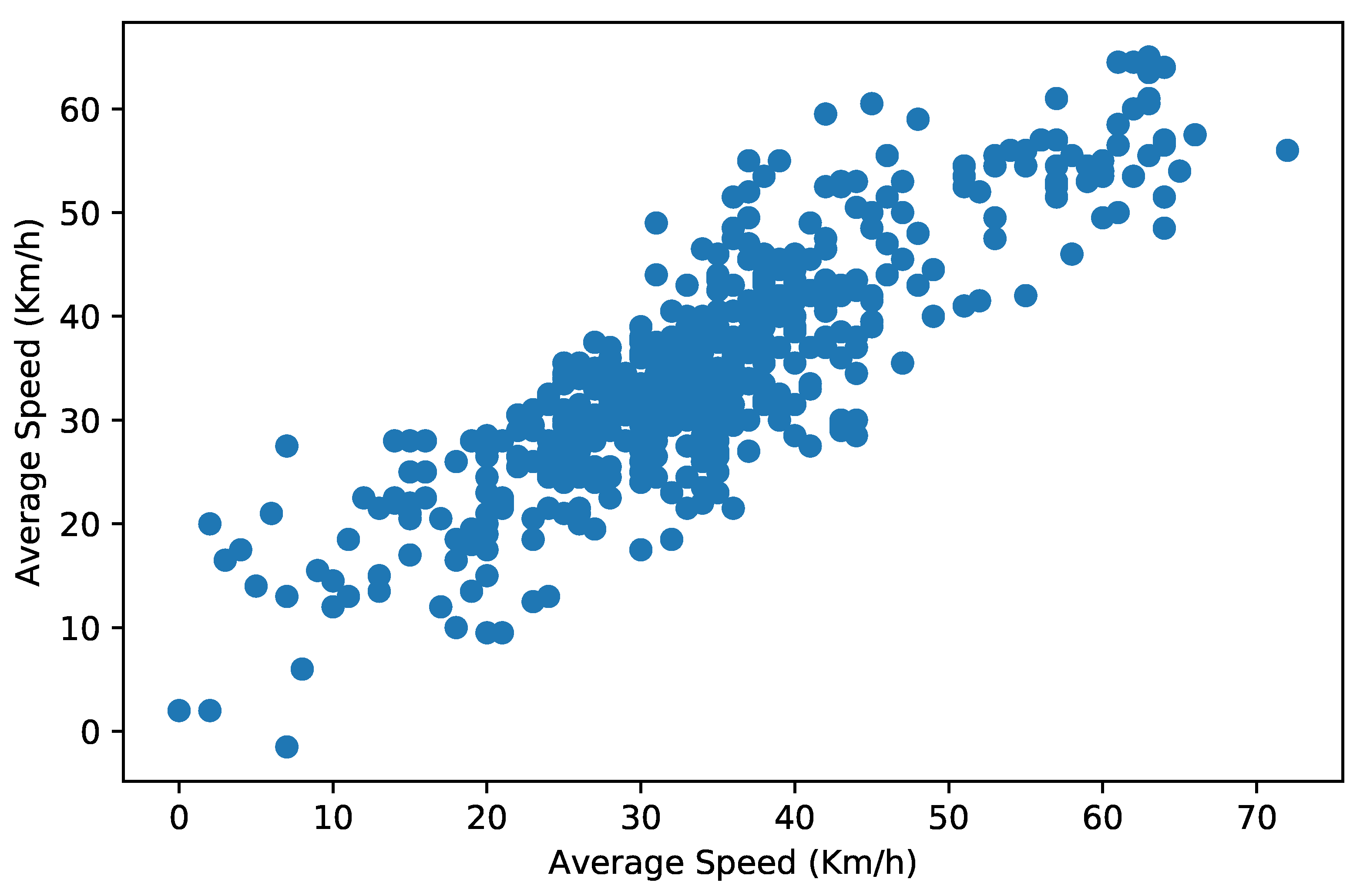
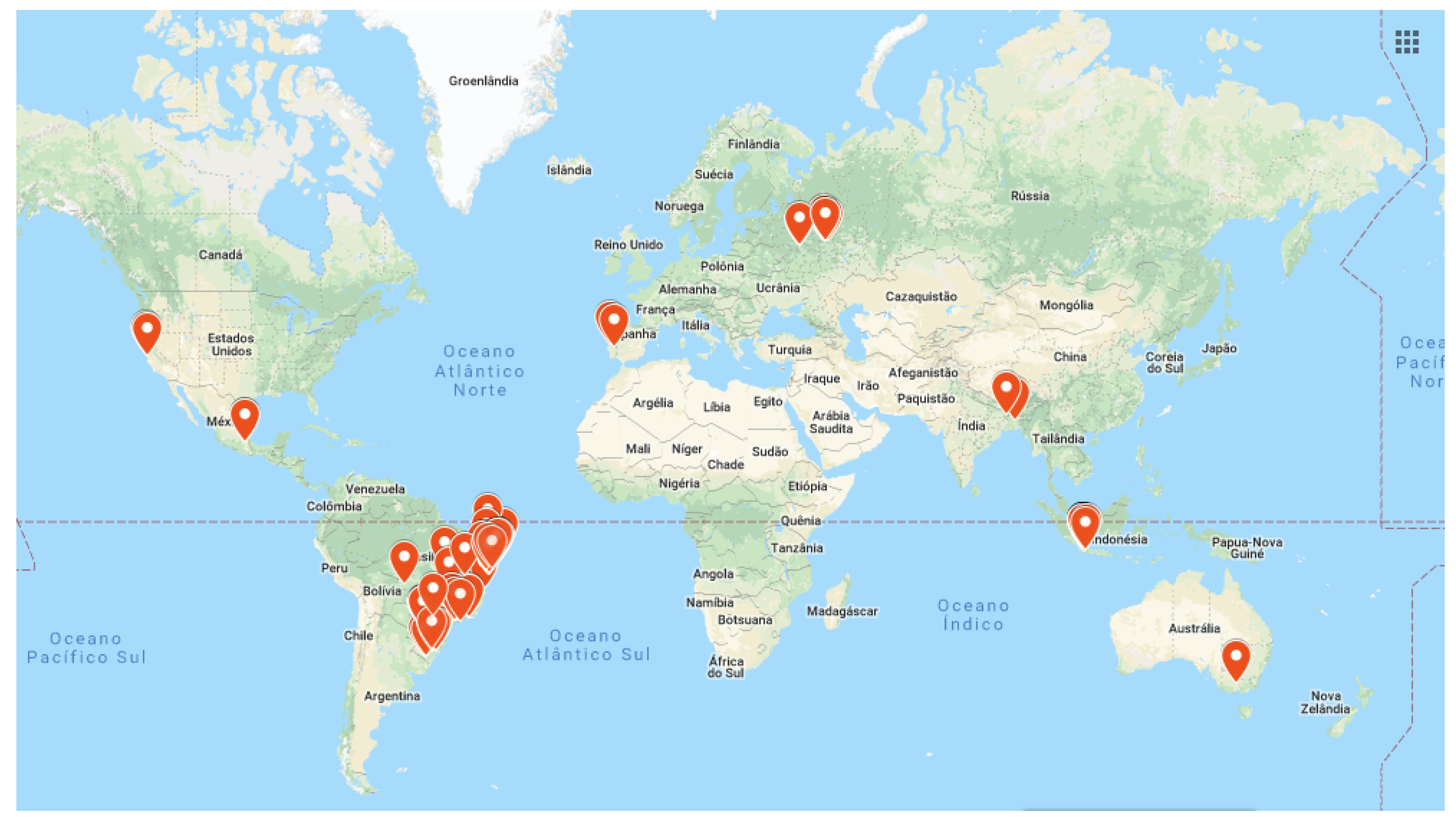
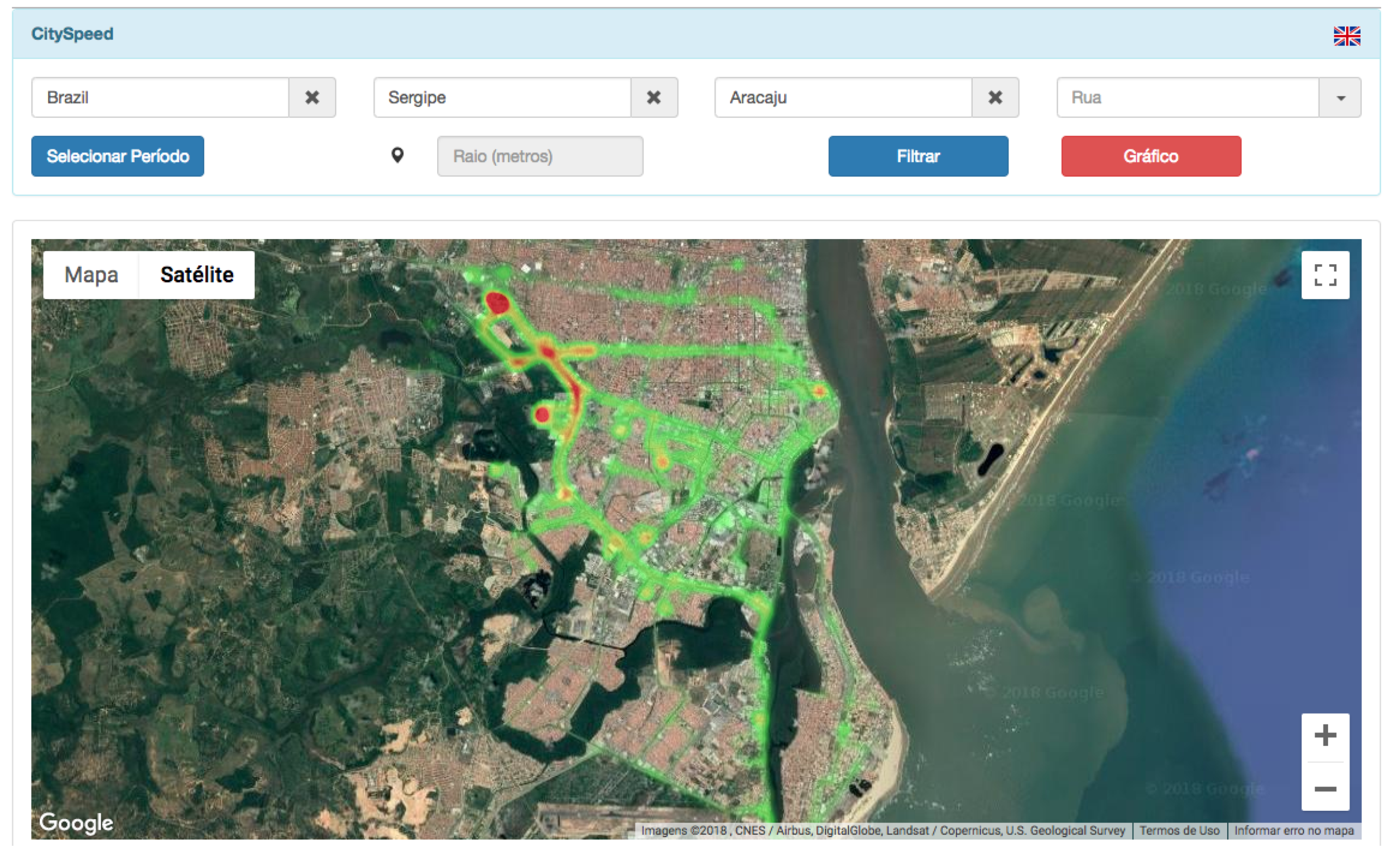
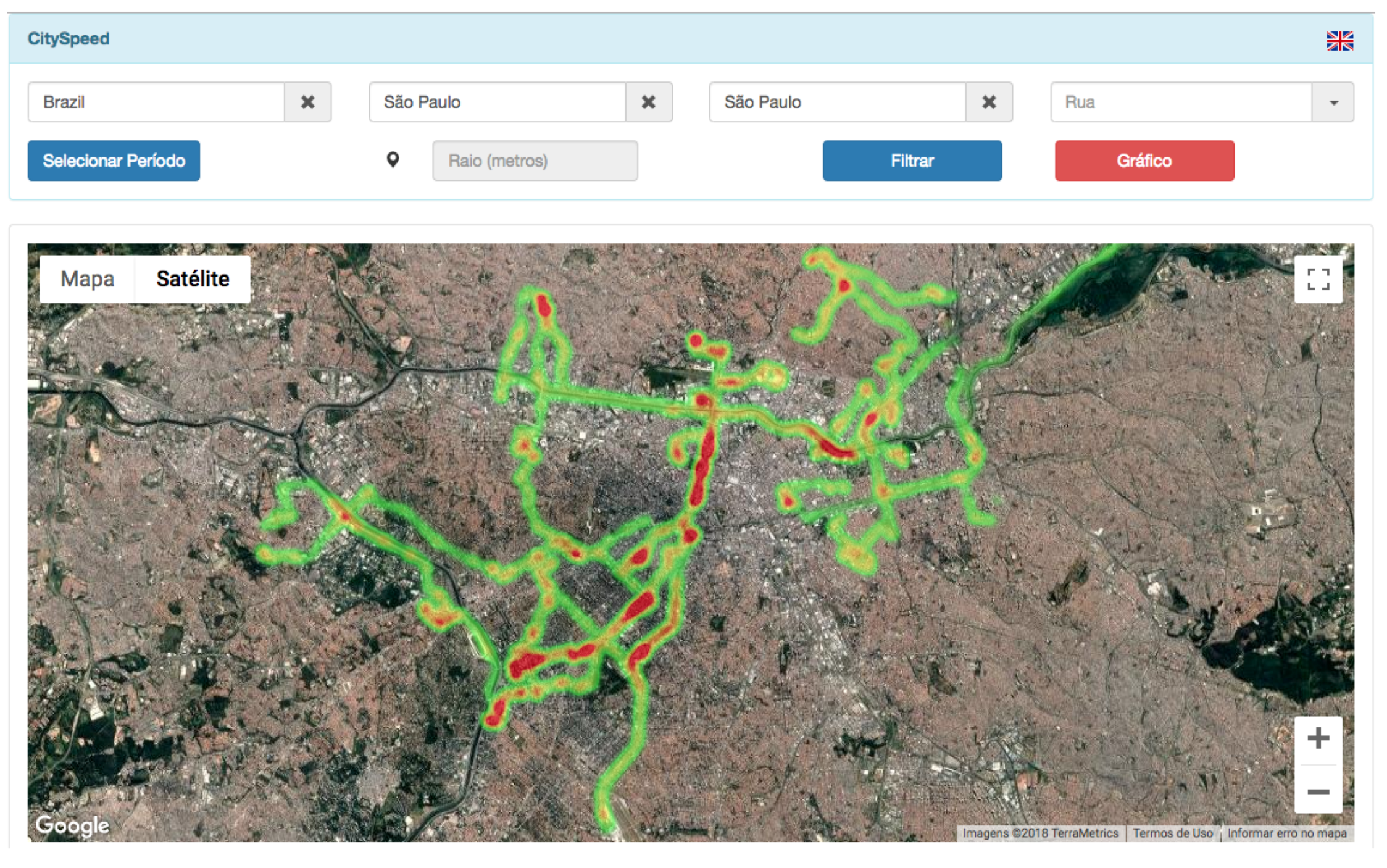
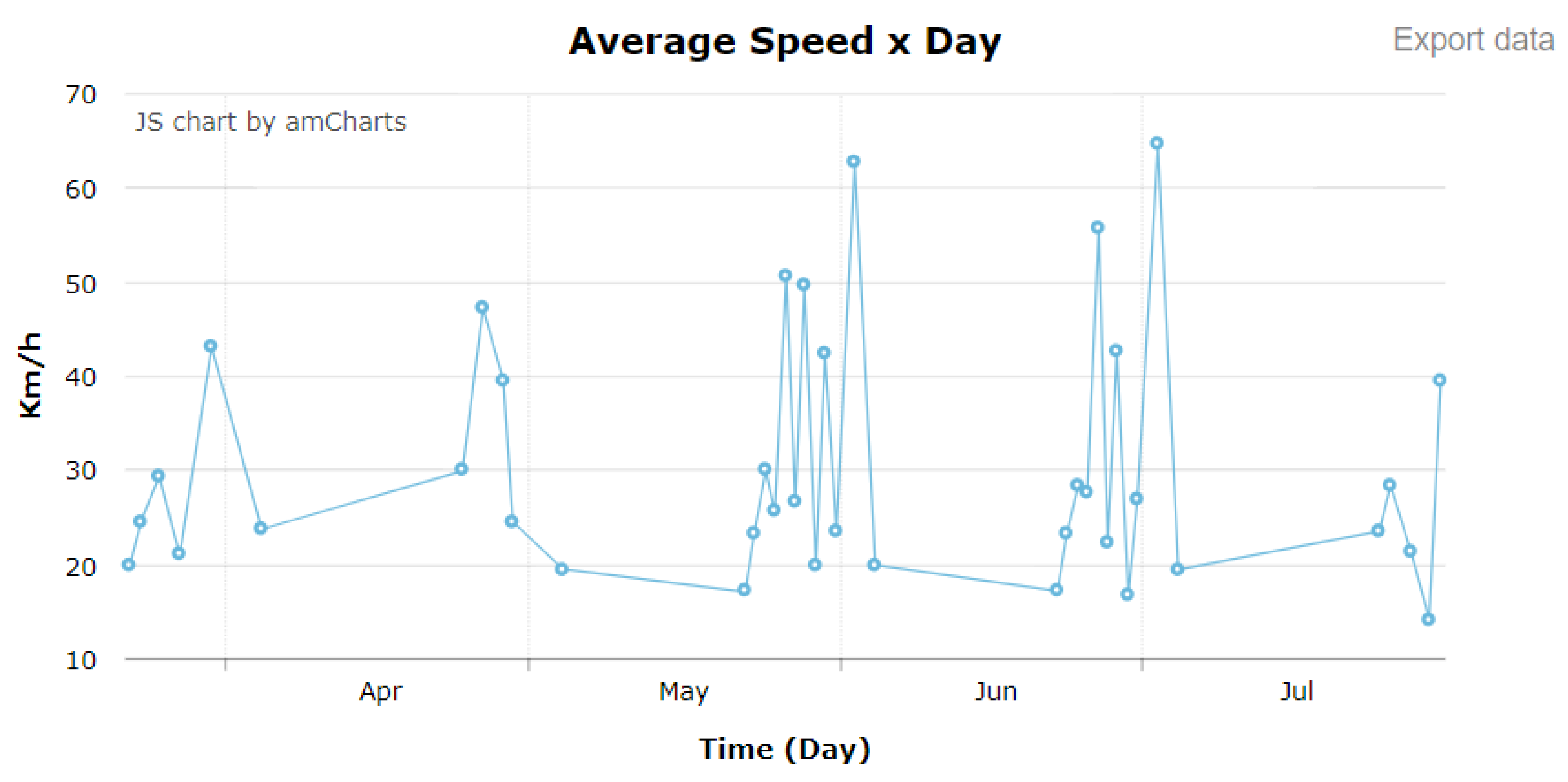
| Work | Year | Acquired Data | Description |
|---|---|---|---|
| Hu et al. [33] | 2013 | Generic tasks | A generic task-centric platform with additional reliability guarantees. |
| Cardone et al. [32] | 2016 | Generic tasks | A platform for crowdsensing performed by students. It may define “tasks” for the users. |
| Dutta et al. [35] | 2016 | Air pollution | An additional device is attached to smartphones, which participates by providing information about air quality. |
| Zappatore et al. [36] | 2016 | Sound | Embedded microphones in smartphones are used to provide information about noises. |
| Wang et al. [37] | 2016 | Vehicular speeds | Acquires vehicular speeds and employs correlation methods to provide perceptions of average speeds over roads. |
| Silva et al. [13] | 2019 | Vehicular emissions | This crowdsensing platform acquires pollution data from OBD-II interfaces and distributes them through smartphones. |
© 2019 by the authors. Licensee MDPI, Basel, Switzerland. This article is an open access article distributed under the terms and conditions of the Creative Commons Attribution (CC BY) license (http://creativecommons.org/licenses/by/4.0/).
Share and Cite
Costa, D.G.; Damasceno, A.; Silva, I. CitySpeed: A Crowdsensing-Based Integrated Platform for General-Purpose Monitoring of Vehicular Speeds in Smart Cities. Smart Cities 2019, 2, 46-65. https://doi.org/10.3390/smartcities2010004
Costa DG, Damasceno A, Silva I. CitySpeed: A Crowdsensing-Based Integrated Platform for General-Purpose Monitoring of Vehicular Speeds in Smart Cities. Smart Cities. 2019; 2(1):46-65. https://doi.org/10.3390/smartcities2010004
Chicago/Turabian StyleCosta, Daniel G., Adson Damasceno, and Ivanovitch Silva. 2019. "CitySpeed: A Crowdsensing-Based Integrated Platform for General-Purpose Monitoring of Vehicular Speeds in Smart Cities" Smart Cities 2, no. 1: 46-65. https://doi.org/10.3390/smartcities2010004
APA StyleCosta, D. G., Damasceno, A., & Silva, I. (2019). CitySpeed: A Crowdsensing-Based Integrated Platform for General-Purpose Monitoring of Vehicular Speeds in Smart Cities. Smart Cities, 2(1), 46-65. https://doi.org/10.3390/smartcities2010004







